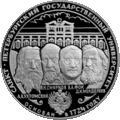Vladimir Fock facts for kids
Quick facts for kids
Vladimir Fock
|
|
|---|---|
 |
|
| Born | December 22, 1898 |
| Died | December 27, 1974 (aged 76) |
| Alma mater | Petrograd University |
| Known for | Fock space Fock state Fock matrix Fock representation Fock–Lorentz symmetry Fock–Schwinger gauge Klein–Fock–Gordon equation Hartree–Fock method Mehler–Fock transform Adiabatic theorem Creeping wave Relativistic dynamics |
| Scientific career | |
| Fields | Physicist and mathematician |
| Institutions | Petrograd University State Institute of Optics Leningrad Institute of Physics and Technology Lebedev Physical Institute |
| Notable students | A. D. Aleksandrov F. I. Fedorov Yu. A. Yappa |
Vladimir Aleksandrovich Fock (born December 22, 1898 – died December 27, 1974) was a brilliant Soviet scientist. He was a physicist who made very important discoveries. His work helped us understand quantum mechanics and quantum electrodynamics. These are big ideas about how tiny particles in the universe behave.
Contents
About Vladimir Fock
Vladimir Fock was born in St. Petersburg, Russia. He studied at Petrograd University. He graduated in 1922 and then continued his studies there. By 1932, he became a professor at the university.
He worked at several important science places. These included the Vavilov State Optical Institute. He also worked at the Leningrad Institute of Physics and Technology. Later, he joined the Lebedev Physical Institute.
His Scientific Discoveries
Vladimir Fock made many key contributions to science. Most of his work was in quantum physics and the theory of gravitation. He also helped in other areas like mechanics and optics.
Quantum Physics Contributions
In 1926, he helped create an important equation. It is called the Klein–Gordon equation. This equation describes how particles move at very high speeds.
He also developed several concepts named after him. These include Fock space and Fock state. These ideas help scientists understand groups of particles. He also created the Hartree–Fock method in 1930. This method is used to study the behavior of electrons in atoms.
Gravitation and Space-Time
Fock also made big contributions to general relativity. This is Albert Einstein's theory about gravity. He focused on how gravity affects many objects at once.
He wrote important books that helped teach physics. One was Fundamentals of Quantum Mechanics. Another was The Theory of Space, Time and Gravitation. These books were very influential. They helped shape how physics was taught in the Soviet Union.
His Legacy
Vladimir Fock was a full member of the USSR Academy of Sciences. He was also part of the International Academy of Quantum Molecular Science. He is remembered as a scientist who helped explain Einstein's ideas. He made these complex ideas fit with the scientific views of his time.
See also
- List of things named after Vladimir Fock
Images for kids


